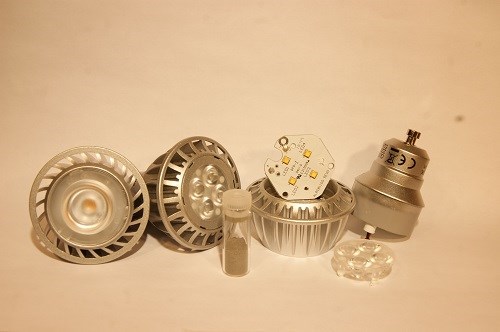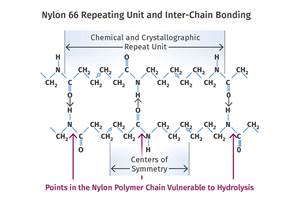Carbodeon Granted U.S. Patent for Nanodiamond-Containing Plastics
With thermally conductive plastics rapidly growing in demand, the addition of nanodiamonds to the arsenal of thermally-conductive fillers is only welcome.

Finland’s has been granted a U.S. patent for its technology which enables detonation-synthesized diamond particles –nanodiamonds (ND)—to be combined with polymers for use in fields such as consumer electronics, LED lighting, automotive and machine tools. The earth’s hardest natural mineral is also one of the most thermally conductive materials known, so when NDs are mixed in with thermoplastics in controlled amounts, they can enable plastics to conduct heat at pre-determined rates, and/or to be highly wear-resistant.
As we reported last year, the company is selling its ultra-dispersed” uDiamond ND fillers via U.S. representative of Nashua, N.H. Available in powder or liquid dispersions, the ND is reportedly fully dispersed into its primary particles without agglomeration. As such, the compounder and end-user can benefit from the entire available ND surface area, resulting in better performance with less material and cost.
ND-impregnated polymers can deliver heat-conducting benefits for products such as LED lighting, mobile devices including cellphones and Internet-of-Things (loT) enabled devices of any type. The hard wearing properties also make them ideally suited for use in the automotive and aerospace sectors to enable longer product life in hard-wear environments.
Carbodeon’s U.S. patent #9085723 is on the company’s developed nanodiamond containing thermoplastic thermally-conductive composites. The patent was filed after the company’s own developments during 2012-2013 whereby they discovered that the thermal conductivity of thermoplastics can be significantly enhanced by adding nanodiamonds, usually is relatively small quantities (e.g., 0.1%). Since filling the patent, Carbodeon has continued their own research as well as developing the range of commercial applications of the technology.
Said company CTO Vesa Myllmaki, “The granting of this patent represents a key part of our nanodiamond composite material portfolio. The combined coverage of our filed and granted patents will secure our position and that of our customers in several nanodiamond applications including polymers for thermal management applications, wear- and corrosion-resistant nanodiamond metal finishing, and wear-resistant/low-friction nanodiamond fluroropolymer coatings.”
A recently-released report, “Thermally Conductive Plastics Market by Raw Material, by End-Use Industry—Global Trends and Forecast to 2020”, by India’s market research firm , projects a 14.3% annual growth of thermally conductive plastics over the 2015-2020 period. The report notes that thermally conductive plastics are used in a broad range of industries including electrical & electronics, automotive, industrial, healthcare, and aerospace. In 2015, the electrical & electronics segment accounted for the largest market share among all the end-use industries in terms of volume, followed by automotive, industrial, and healthcare. Among all the end-use industries, healthcare is estimated to grow at the highest annual rate.
Another interesting tidbit from this study is that rising demand from North America is the major driver for thermally conductive plastics. In 2015, North America is estimated to account for the largest market share in terms of volume, and is estimated to remain the market leader in the next five years. The use of shale gas as raw material for producing polymers has lowered the price of thermally conductive plastics and is boosting demand in this region. Within the last two years, the U.S. led the demand for thermally conductive plastics due to increased demand of LED lighting. Markets in emerging economies, such as Mexico, China, and India are projected to grow very rapidly.
Key companies profiled by this study are:,, Saint Gobain, , Hella KGaA Hueck & Co.,, , ., ., and
Related Content
What is the Allowable Moisture Content in Nylons? It Depends (Part 1)
A lot of the nylon that is processed is filled or reinforced, but the data sheets generally don’t account for this, making drying recommendations confusing. Here’s what you need to know.
Read MoreThe Fantasy and Reality of Raw Material Shelf Life: Part 1
Is a two-year-old hygroscopic resin kept in its original packaging still useful? Let’s try to answer that question and clear up some misconceptions.
Read MoreScaling Up Sustainable Solutions for Fiber Reinforced Composite Materials
Oak Ridge National Laboratory's Sustainable Manufacturing Technologies Group helps industrial partners tackle the sustainability challenges presented by fiber-reinforced composite materials.
Read MoreBASF Highlighting How They 'Make, Use and Recycle Future Solutions'
NPE2024: BASF is using its proprietary computer-aided engineering tool Ultrasim when designing for sustainability in a broad range of industries.
Read MoreRead Next
Making the Circular Economy a Reality
Driven by brand owner demands and new worldwide legislation, the entire supply chain is working toward the shift to circularity, with some evidence the circular economy has already begun.
Read MorePeople 4.0 – How to Get Buy-In from Your Staff for Industry 4.0 Systems
Implementing a production monitoring system as the foundation of a ‘smart factory’ is about integrating people with new technology as much as it is about integrating machines and computers. Here are tips from a company that has gone through the process.
Read MoreSee Recyclers Close the Loop on Trade Show Production Scrap at NPE2024
A collaboration between show organizer PLASTICS, recycler CPR and size reduction experts WEIMA and Conair recovered and recycled all production scrap at NPE2024.
Read More













